(Continued from the last page.)
We sort of convoluted that quote by having very few fixed plans on our way
to and within Alaska. We were definitely intent on arriving
there, however, so our plan was to get there as quickly as possible and
spend more time on the return in Canada.
As mentioned on a previous page, even that vague plan was altered in September.
PLAN OR NO PLAN?
The shorter your stay in Alaska (e.g., only one or two weeks), the
more important it is to make definite reservations for accommodations
and tours -- especially if you're there between mid-June to mid-August
when the majority of other tourists are visiting.
You simply don't have the luxury
of time to be hunting for a suitable place to stay if you're on a rather
tight schedule.
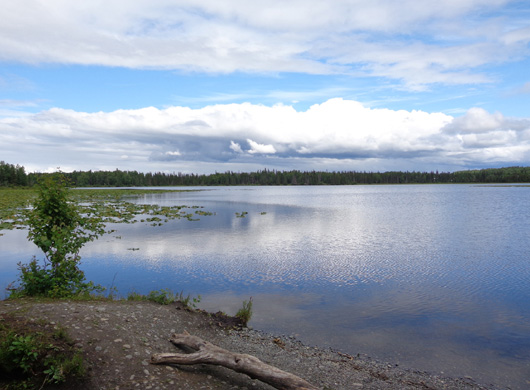
Scenic Johnson Lake is across the
road from the Kasilof RV Park on the Kenai Peninsula. (7-13-12)
The longer you can spend in Alaska (e.g., a month or more), the more
flexible and spontaneous you can be regarding campsites, motel rooms,
tours, etc. If one area is packed and you can't find a place to stay,
you can move somewhere else and return later when it's not as busy.
It really doesn't take that long to drive between most of the popular
tourist areas in Alaska so if you want to backtrack some, it's not a big
deal. We were in Anchorage three times, Denali NP twice, and wandered
back and forth a little bit over the busy Kenai Peninsula while we were
there.
We also did quite a few day trips from central locations like
Anchorage. That was easier than moving the camper more frequently.
IN DEFENSE OF SPONTANEITY
Because we're retired and had what seemed in June like lots of time
to spend in Alaska, we had the advantage of being very spontaneous about
where we went and how long we spent in each locale. We made fewer long-term
plans and reservations during this trip than any previous ones we've taken.
That MO caused some occasional angst but worked out very well overall.
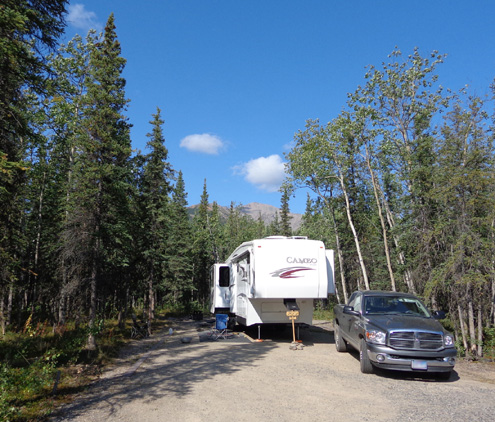
One of the spacious sites we
occupied at Riley Creek CG in Denali NP (8-14-12)
The only campground reservations we made
before reaching Alaska were at Denali National Park on our first visit in early
August. We made reservations at Riley Creek and Teklanika campgrounds as soon as we could
do it online (December 1, 2011). We made our Tek Pass shuttle bus
reservation at the same time.
Advance reservations were a good thing because that was still the
height of the season at the park.
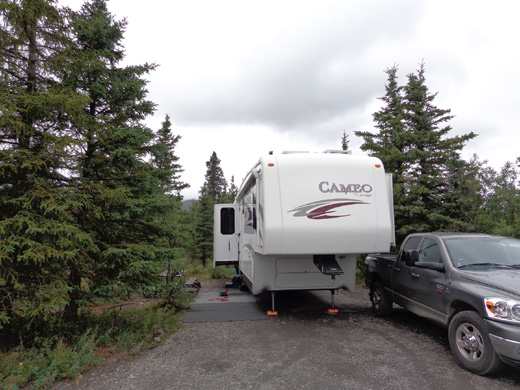
Teklanika CG is 29 miles back the
park's interior road. We enjoyed camping there for four nights
(there is a three-night minimum).
We had a boreal forest and wide riverbed behind our site. (8-9-12)
To our surprise, however, we were able to extend the Riley Creek reservation at the campground office
by three more days when we saw how great the weather was, and we made
our second reservation at Riley for eight days at the end of August/beginning of
September just a few days before going back to the park.
My point is, even at uber-popular Denali National Park you don't
always have to make reservations far in advance.
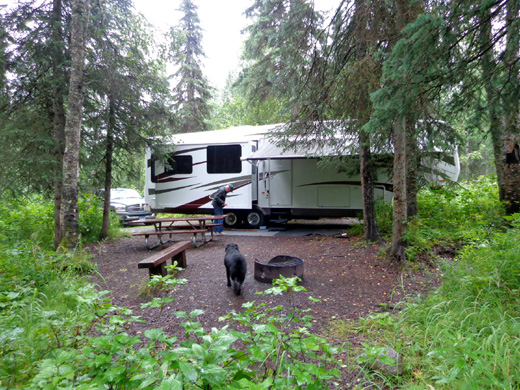
Our site at Byers Lake Campground
in Denali State Park, located SE of Denali National Park (8-2-12)
Every other place we stayed was either spur of the moment or with a
couple days advance notice.
The main reason was to maximize spontaneity so we could stay longer
in some places than we thought we might, or move on earlier than we
anticipated for one reason or another (crowds, rain, etc.).
We also stayed at military campgrounds in Valdez, Seward, Anchorage,
and Fairbanks. The only one of those where we could make a reservation
was the Seward Military Resort. The other ones were first-come,
first-served. We had no problems getting nice sites at any of them.
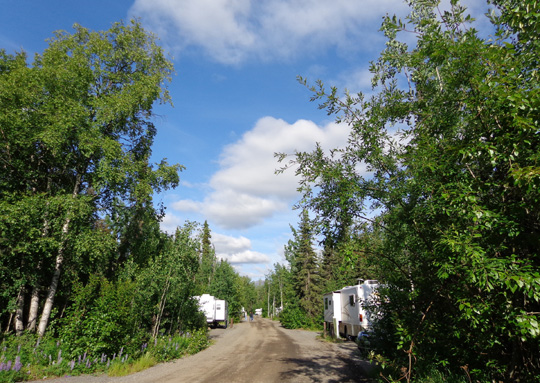
We liked the Black Spruce CG
at Joint Base Elmendorf-Richardson (JBER) in Anchorage
so much that we stayed there
three times for a total of almost six weeks. (6-29-12)
We had a bit of a problem in Seward when we decided we wanted to stay
longer at the military resort. We were able to extend for two more days
but came up one day short because the campground was full the third day.
We just moved across the street to the Air Force campground the last
day. It was less expensive and we had more room, so the only "problem"
was having to move.
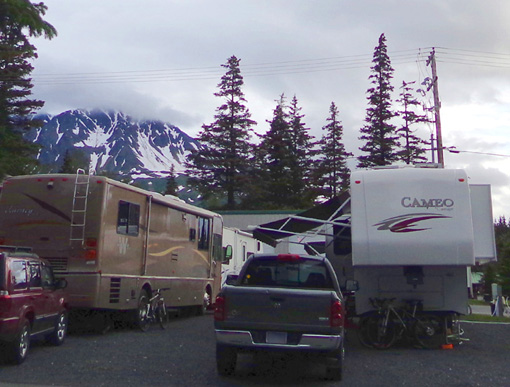
The RV sites at the Seward
Military Resort are small but the price and location are great.
(7-7-12)
Our timing to visit the Kenai Peninsula wasn't real good but I don't
know how we'd do it any differently the next time.
Various rivers on the peninsula are very popular destinations for residents when
the salmon are running. At least five kinds of salmon come back to spawn
anywhere from mid-June to mid-September so there isn't much leeway
weather-wise to better time a visit to the Kenai if you don't fish.
That time period also includes the peak tourist season. Many tourists
time their visits to the Kenai for optimal fishing opportunities.
We solved that problem by staying several days at a small private
campground in Kasilof part way down the west coast of the peninsula
and making three day trips in the truck to visit areas we wanted to see
north and south of there. That RV park was much nicer than the parking
lot-type "campgrounds" where the fish-folks crowded together in
Soldotna, Kenai, and Homer:
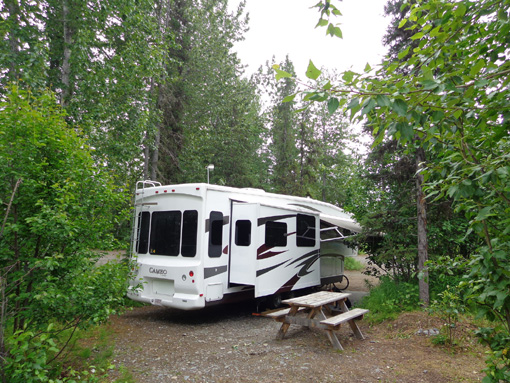
Our site at the Kasilof RV Park, one of the few
private campgrounds we used;
the large wooded sites are similar to those in
public campgrounds. (7-13-12)
We also found some very nice, low-cost provincial (government)
campgrounds in Canada with sites for large RVs. Congdon Creek
and Snag Junction in the Yukon were two with pretty lakes that we enjoyed.
Neither had very many other campers in early June or early September.
Many Canadian towns have attractive city parks with campsites (Hythe,
AB, e.g.) and/or Rotary Club campgrounds we liked, such as the one in
Grande Prairie near the visitor center and bike path:
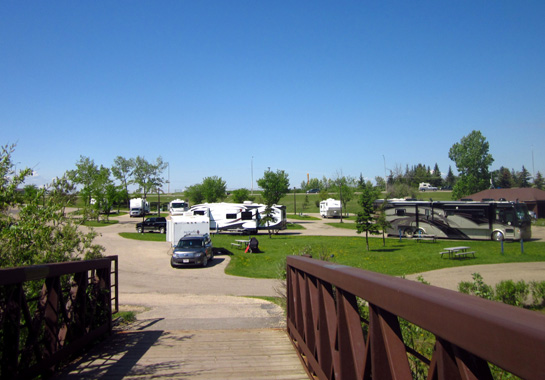
View of our section of the Rotary RV Park from the
bike path in Grande Prairie (6-4-12)
Those were cheaper than the private campgrounds we used in Dawson Creek,
Fort Nelson, and Watson Lake.
The campground in Grande Prairie was nearly full when we
got there in early June but only three couples camped at the city park in Hythe in
mid-September:
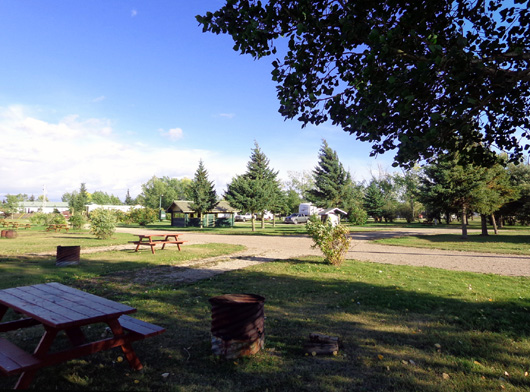
Nice city RV park in Hythe, AB that was nearly
empty when we camped there overnight (9-10-12)
In Calgary, Whitecourt, and Olds, Alberta we stayed overnight for
free at Walmart stores a total of four times out and back. That practice
is as popular in Canada as it is in the U.S.!
FINDING CAMPGROUNDS
It was usually pretty easy for us to find places to camp, even without
reservations. We would have had more options with a smaller RV but most
places in which we were interested had sites for large trailers and motorhomes, too.
I already mentioned having to move across the street to another
military campground in Seward when we wanted to extend our reservation.
The only other campground problem we had was with our original site
at the Russian River National Forest Service campground on the Kenai
Peninsula. When we made an online reservation a few days before the 4th
of July holiday we had to select a specific site. We'd never seen the
campground before so it was a shot in the dark, based only on online
information about the size and location of the site.
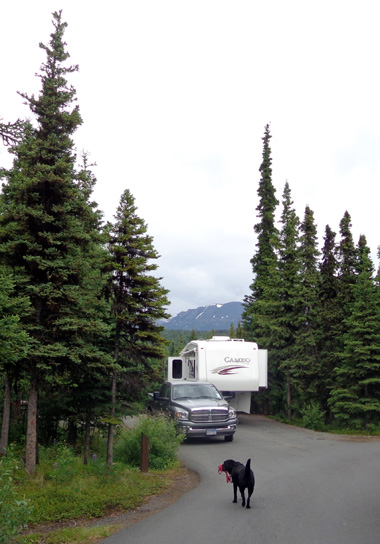
Self-walking dog: Cody
carries his leash toward our camper
at the end of a walk at the
Russian River CG. (7-11-12)
The site we blindly picked was long enough and wide enough for the
Cameo but there was no maneuvering room on the campground road across
from the site to get into it (trees and shrubs in the way of turning the
truck). We were able to move to another site shown above but because the campground
was so full then, we could get the larger site for only two of the three
nights we wanted to stay there.
It turned out OK. We found a scenic turnout a few miles down the road
where we boondocked for a peaceful afternoon and night the
third day:
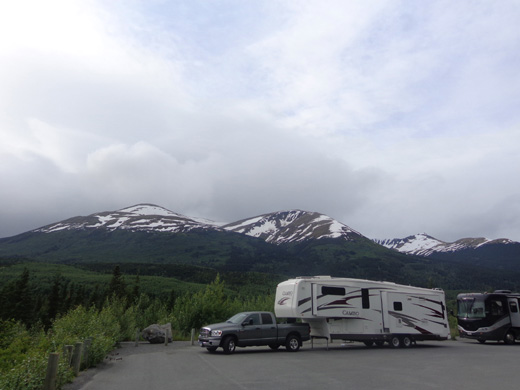
Three other RVs liked the spot so well they tucked in behind us! They
were quiet and I felt a little safer with them there. The next morning
we continued on our merry way to Seward after the holiday crowds were
gone from that town.
Some of our "spontaneity" re: finding
campsites caused a little temporary angst but we were able to overcome
the challenges by being flexible and open to experimenting with alternatives.
We'll probably use the same MO when we go back the next time.
BOOKING DAY TOURS
Our spontaneous decisions re: a day cruise out of Seward to
Kenai Fjords National Park and a flight-seeing plane ride from Healy
over Denali National Park also worked out well.
We debated about getting a coupon book for half-price day tours and
admissions to various tourist attractions in Alaska but decided against that
because advanced reservations were required for most of the places
offering coupons. We also wanted to check out
the businesses and options in person, not just from ads and online journals.
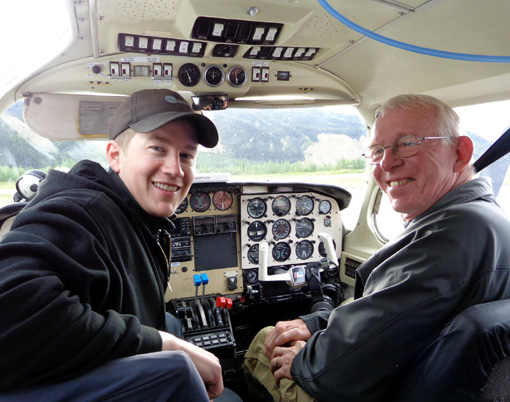
One of Jim's most memorable days
in Alaska was our flight over Denali when he
got to sit in the
co-pilot's seat next to our personable pilot, Trent. (8-7-12)
We made reservations for both trips just one day in advance, after we
had time to do some on-site research and were certain the weather
would be good.
We're glad we did it that way, even if it cost us more for tickets.
We got military discounts on the cruise and our campground host at
Denali arranged a sweet deal for us on the plane ride.
There are several cruise and plane tour operators in various
locations and each has lots of different packages, so the chances of
booking a fun day trip on short notice are pretty good even during the
height of the tourist season.
SOME OTHER CHALLENGES WE FACED
The good news is, we had very few things go wrong on this trip with
route-finding or mechanical problems with our truck or 5th-wheel camper.
The bad news was the weather in Alaska this year.
ROUTE-FINDING & GPS UNITS
We discovered that a GPS with updated Canada/Alaska information is
great to have but not essential with the other routing information we
had at hand and on our computers.
We bought a new Garmin Nuvi 1490 GPS before our trip because our old
Magellan unit wasn't programmed for Canada. It worked well on our trip
up to Alaska but self-destructed soon after we reached Anchorage the
first time in June.
We're not real fond of the free refurbished replacement Garmin sent us. The software wasn't
current for either Canada or the U.S. and
required a large number of gigabytes and too much time to update with
the weak or non-existent internet connections we had available to us
most of the time in Alaska.
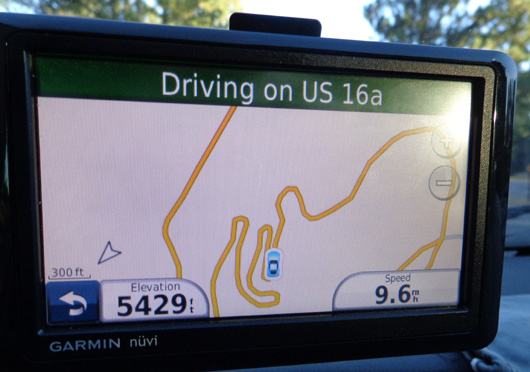
I didn't think to take a picture
of the Garmin GPS while I was driving in Alaska or Canada. I took
this one recently while driving
(slowly!) on a twisty road through the Black Hills of South Dakota.
The Nuvi suited our needs fine while we were in Alaska so Jim delayed updating
it until we were ready to leave and he found a strong enough free WiFi signal to
do the job. However, he was able to update only the
American part of the software (long story) and not Canada, too. The GPS
unit was basically useless during the trip back through Canada.
The Canadian maps and descriptions in the 2011 Milepost book, 2011
Alaska Camping book, our topo software, and two- to three-year old AAA maps
supplemented what old information we had on the GPS. We also remembered
most of the Alaska Hwy. from going outbound on it.
However, new highway interchanges in Edmonton and Lethbridge, Alberta caused us to get
off-course briefly in both those cities because none of our
routing information was up to date.
Otherwise we found our way through Alberta, British Columbia, the
Yukon, and Alaska with few to no problems.
The Nuvi works fine in the U.S. so we'll probably keep it. By the time
we go back to Alaska again it'll be time to get a new GPS unit anyway.
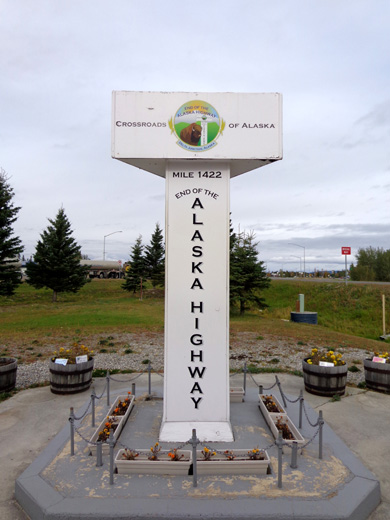
The end of the Alaska Hwy. is at
Delta Junction, AK if you follow it
all the way north. The road was
originally 1,422 miles from Mile 0 in
Dawson Creek, BC but is shorter now because of
several re-routes. (9-6-12)
As with any electronic device, do not blindly follow GPS
directions, especially with an RV!!
You may have heard horror stories about folks with RVs being
directed to dead-end or very narrow streets, under extremely low
bridges, or worse. Once we had to back up the camper after "Maggie" told
us to turn on a dead-end street. It worked out OK but caused unnecessary
stress.
Fortunately that's the worst RV-GPS misadventure story we have. While
we were in Alaska a man followed his GPS in his car, not an RV, right
into the water in Prince William Sound when he exited the tunnel to the
port town of Whittier!
I forget whether he drowned or not.
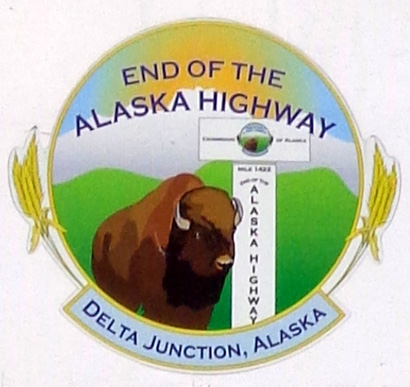
We drove the Alaska Hwy. from
Dawson Creek to Tok 1,282 miles) on the way to Alaska
and the whole thing (1,390 miles)
from Delta Jct. to Dawson Creek on the way back.
That's not the first story (or the last) I've head about GPS
directions sending people into dangerous situations.
Not only is it difficult to keep the software updated every time a
road is built, rerouted, or closed, most GPS units don't take into
account the length, width, and height of an RV. It's best to buy one
that is manufactured specifically for truckers or RV owners. They are
more expensive, which is why we didn't get one of them in the first
place.
As with the inadequate camera we bought in Anchorage, frugality isn't
always wise.
MINOR MECHANICAL ISSUES
We did very well regarding truck and camper problems, too.
In our research we read about other RVers' problems with flat tires,
broken springs and shocks, chipped windshields, and filthy campers from
their treks through Alaska and northern Canada. We avoided some of those
problems by sticking to paved roads when pulling the Cameo, by being
very alert to rough places, and by driving very slowly when necessary.
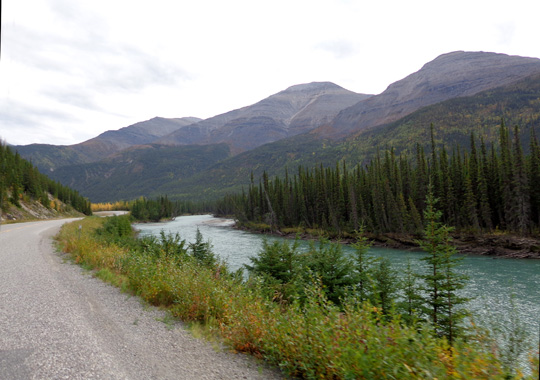
Although it's in a remote
location in northern BC the Alaska Hwy. was fairly smooth
along the Toad River, a beautiful
glacial-blue stream with an unattractive name! (9-9-12)
Fortunately, we had no flat tires, no windshield chips, and no
mechanical problems with the truck or camper other than an issue with
the hitch when we got back to the Lower 48.
That's pretty good, considering our 2008 Dodge Ram 2500 diesel
pick-up now has over 91,000 miles on it. Jim does all the
maintenance and is a stickler about doing it regularly. We also started the
trip with fairly new truck tires, which helped.
The camper tires were a year old when we started out but still in
good enough shape that we had no problems with them, either.
We have a tire pressure monitoring system (TPMS) that alerts us to
any high or low pressures or temperatures. The alarm never went off,
partly because Jim kept the pressure a little lower than usual and the
weather was cool all summer.
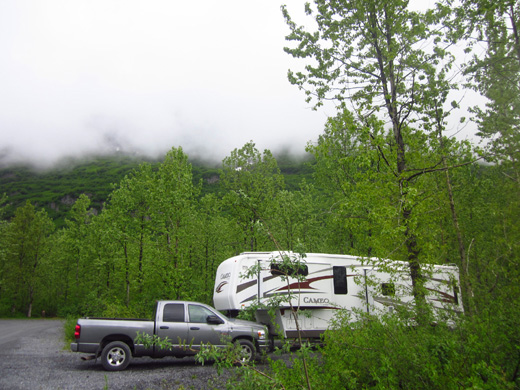
Cool?? That's an understatement.
Low clouds hung over the Valdez Glacier CG and
snow covered the nearby mountains
down to sea level on this day in mid-June. (6-14-12)
We did have three "hassles" with the truck and camper, however.
One was keeping the truck and camper clean. Every chance he got Jim washed both the truck and camper with a hose at our
campsites. Many of the private campgrounds in Alaska and along the Alaska Highway
in Canada also have RV washes, most for an extra fee.
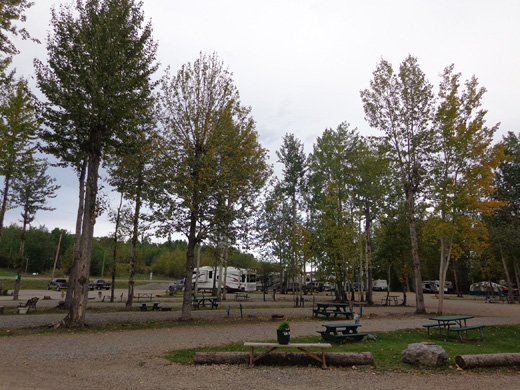
We stayed at the Triple G Campground in Fort
Nelson, BC again on our way back in September. This time
it wasn't raining and there were many fewer RVs.
This campground has an RV wash for a hefty sum. (9-9-12)
The only other vehicle problem we had was the sliding handle to the
hitch head in the bed of the truck got bent on the way back through
Canada and had to be replaced. Jim fixed that when we got back to Montana.
The Curt company replaced the hitch head for free (five-year warranty) and
it was delivered right at our campsite via FedEx in less than 24 hours. Jim was able to force the handle out
to disconnect the camper. He removed the old hitch head and mounted the new
one by himself.
He's currently researching different types of hitch heads and pin
boxes that are designed to eliminate some of the shaking and "bucking" between trucks
and trailers so our next trip will be more comfortable in that regard.
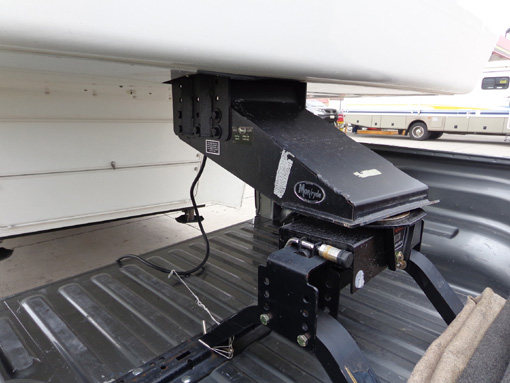
One view of our Mor-Ryde pin box
(attached to camper) and Curt hitch (attached to truck bed)
WEATHER WOES
This probably wasn't the best summer for us to visit Alaska but we
had such a good time overall that we don't regret our decision to go. We
just dealt with the challenges and enjoyed the adventure.
Fuel prices were at or near all-time highs, the parts of Alaska
we visited in the South Central region had record-breaking levels of
snow last winter, and the region also had a much wetter, colder summer
than normal.
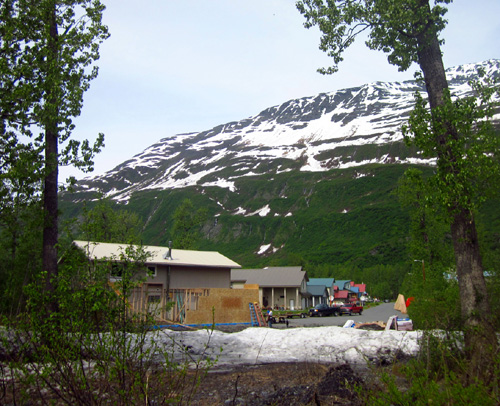
In mid-June piles of snow remain in this
neighborhood at sea level in Valdez. There were even higher
snow piles in some vacant lots downtown, ye the
trees all sported green summer leaves. (6-16-12)
Winter is always long and brutal in Alaska. The winter of 2011-12 was
worse than usual.
The roads were clear when we got there but spring was late and some
of the trails I hiked were still under snow or completely impassable
until later in the summer. Some flooding occurred as late as mid-summer
because of the late snow-melt and summer rain.
From our perspective the only good thing about all the excess winter snow and chillier
temperatures was a reduction in the number and size of the huge mosquitoes and flies we'd been
warned about. We never needed the mosquito nets we purchased. We didn't
even have to use our insect repellent.

Mist hangs in the air as Jim and Cody inspect the
old Beeman Cabin above Byers Lake
at Denali State Park. We didn't even need mosquito
repellant in that wet environment. (8-2-12)
We knew about the tough winter before we began our trip.
We couldn't have accurately predicted the cold, wet summer, however.
The flooding in Alaska didn't affect us (only the flooding in the Yukon on our way
up) but the frequent rain was depressing and limited some of our activities. June
and July were cooler and wetter than normal in the South Central area;
August was a little drier and warmer than normal.
I read that July was the coldest on record in Anchorage. Here's an
online article you might find interesting:
http://www.alaskadispatch.com/article/anchorage-makes-weather-channels-top-5-worst-summer-weather-2012

How wet was it? Even the mushrooms were furry at
JBER by the end of summer!! (8-22-12)
When we periodically read/heard about the millions of people in the Lower 48
who suffered this summer from prolonged high heat and serious drought
conditions . . . you can understand the irony and why we had
trouble relating to that. We felt like we were on a different planet.
We were definitely in a different ZIP code!
As a result of the frequent cold, wet weather we stayed in
campgrounds with electric and water hookups more frequently than we
thought we would. It's a lot more comfortable to boondock (no electric
or water hookups) in warmer, drier conditions than it is when it's wet.
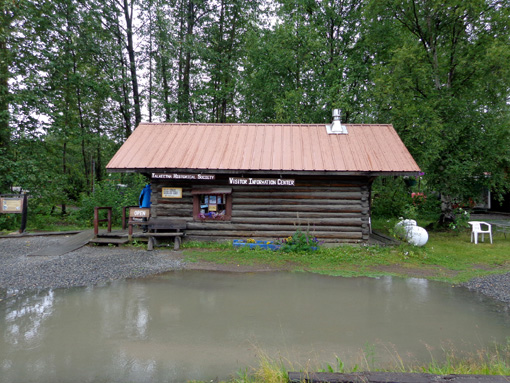
A large puddle fills half the
parking lot at the Talkeetna visitor center. (8-2-12)
Rain and cold temperatures weren't the only problems Anchorage had this summer.
While we were in Fairbanks in early September we heard/read about
extremely high straight-line winds in the Anchorage area -- and we were glad we
weren't there!
Wind velocities of up to 130 MPH were recorded in foothill subdivisions
in the Chugach Range on the east side of the metro area. That's where we
accessed several trails into the mountains, including the popular
Flattop Mountain trail. Trees and utility lines were down all over the
city and thousands of folks were without power for days.
Residents are accustomed to storms like this in the winter but
apparently they are unusual in the fall.
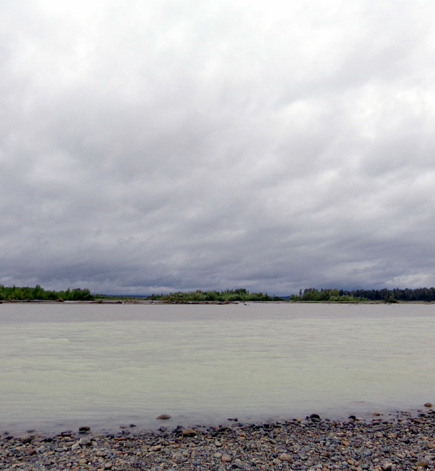
The broad Talkeetna River on an overcast day in
August;
the water was high but not flooding the town then. (8-2-12)
Excess rain caused further problems in South Central and Interior Alaska
later in September, after we were back in the Lower 48. We read accounts
of serious flooding in Talkeetna (three rivers converge there), the
Mat-Su Valley, Kenai Peninsula, and other areas of the state.
By late September Anchorage was already getting some snow. Residents
bemoaned the short autumn season.
Many Alaskans just didn't get a break re: the weather this year.
Continued on the next page: tips re: the condition and
type of vehicle(s) you drive to and/or around Alaska
Happy trails,
Sue
"Runtrails & Company" - Sue Norwood, Jim O'Neil,
and Cody the ultra Lab
Previous
Next
© 2012 Sue Norwood and Jim O'Neil
























